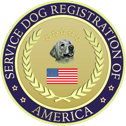Dog Body Language: More Than Just Wagging Tails
2019-02-26Dogs have evolved with humans for thousands of years so it’s no surprise that they have become great communicators. Of course, if you know people you also know that we don’t always listen or pay attention to what we should. Your dogs and service dogs communicates with you in a lot of ways. Just like us, they rely on body language to let you know how they’re feeling or what they’re thinking. By learning to recognize some basic dog body language, you will find that your ability to interact with, understand, and enjoy your dog will greatly improve. The most important thing to remember is that anyone can easily understand dog body language if they know what they are looking for. This isn’t something that takes years of training or practice – just patience and a good eye.
Dog experts have identified 4 main emotional states that dogs can be in:
Timid, Excited, Aggressive, and Submissive. Each of these emotional states comes with different and distinct body language to help you know where your dog is at.
TIMID
Timid dogs will have their tail between their legs, pin their ears close to their head, and have very open eyes. These are some obvious signs you may already know. But timid dogs also usually shiver and yawn. The last one is great know. When we see dogs yawn, we may assume they’re just tired. While they do yawn when tired too, a yawn with these other signs is a great indicator your dog is feeling especially shy or uncomfortable.
EXCITED
On the other hand, excited dogs will have their tail way up in the air. Of course, there are different kinds of excited. A tail that’s up but not wagging so much and combined with a tense body usually means your dog is very focused on something. A tail wagging widely and a lot of movement means your dog is just overwhelmed with excitement. Probably how the little guy acts when you come home from work!
SUBMISSIVE
Submissive dogs have their particular body language as well. The most common of these are looking away and/or exposing their belly. Looking away, unlike in humans, is not a sign of discomfort – for dogs this can mean that they show trust and are non-threatening. Showing a belly is the gold-standard sign of submission and trust, as the dog is telling you he feels comfortable enough to expose the most sensitive parts of his body to you.
AGRESSIVE
It may be most important to be able to recognize an aggressive dog. Some signs are obvious, like growling or bearing teeth. But there are other, less obvious signs that should raise equally big red flags. An early sign of aggression can actually be a closed mouth. This usually means the dog is especially focused or tense about something he’s noticed. This is not so much aggression, but if what they’re focused on is seen as a danger (like another dog they don’t like) it can quickly escalate to real aggression. Another sometimes hard to notice sign is raised hair on the back. This is a great way to tell the difference between rough play and real aggression. If the hair on the back of a dog is standing up, proceed with extreme caution.
Learning these less-obvious signs of dog emotions isn’t just about keeping you safer. It will make you a better and more sensitive handler to your dog as well.
